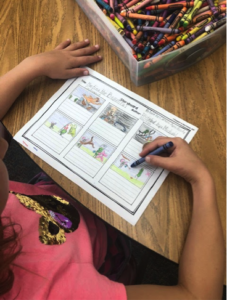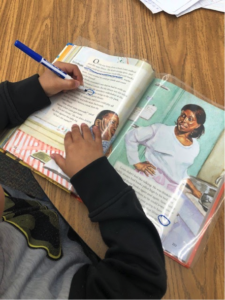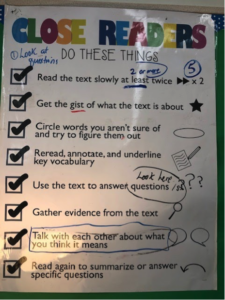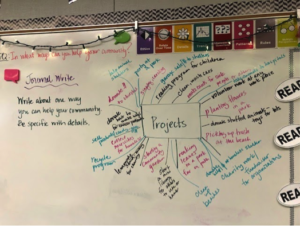Bottom Line
Ask anyone about engaging and effective Reading Comprehension activities and you will get a myriad of replies and suggestions. I know, because I asked! I asked educators and non-educators to send me either activities they used or remember being used when they were students. The good news, there are countless recommendations! The bad news, there are countless recommendations. How does one sift through all of them and find the most effective one for their group of scholars? My father always wants to know “What is the bottom line?” The bottom line is you don’t have to choose just one and you do not have to reinvent anything… but you can!
Teaching has dramatically changed during my tenure. When I started, we were given the Teacher’s Editions with reading materials, reading comprehension activities and told to follow them explicitly. The challenge was that it did not always fit your specific class. Let’s be honest, some of it was just really bad teaching and were anything but effective or engaging and fun was nowhere to be found. More good news is that education has transitioned into a collaborative, creative, and dynamic bundle of unlimited resources that provides the most effective reading comprehension activities for your amazing scholars!
Academic Research
For those of us who want evidence from academic research of proven Reading Comprehension activities, there is no end to exploring this path. Using a guideline or litmus test for effective Reading Comprehension activities is helpful. According to Institute of Education Sciences’s Find What Works, there are six strategies that improve Reading Comprehension. The six strategies are:
- Activating Prior Knowledge
- Asking Questions While Reading
- Visualizing
- Monitor/Check For Understanding
- Drawing Inferences
- Summarize/Retell
(Improving Reading Comprehension in Kindergarten Through Third Grade )
If the Reading Comprehension activity has one or more of these strategies, then the likelihood of success is high. Their research also finds that practice reading with peers, teachers and independently is a key factor for effectiveness. In addition, there needs to be a gradual release of responsibility to the learner. The goal is for the learner to have more ownership in their reading growth and success. Therefore, choice of text is important in this process as well.
Transactional Strategy Instruction
One example that follows these strategies is Transactional Strategy Instruction. According to MSU, “Transactional Strategy Instruction (TSI) is a procedure that involves teaching students to construct meaning as they read by emulating good readers’ use of comprehension strategies.” TSI also helps students (1) set goals and plan for reading, (2) use background knowledge and text cues to construct meaning during reading, (3) monitor comprehension, (4) solve problems encountered during reading, and (5) evaluate progress. The learners use specific strategies such as predicting based on prior knowledge, generating and asking questions, visualizing, summarizing, and others which all are in direct line with the aforementioned six strategies. This activity is done in a small group setting that encourages dialogue between peers and the instructor. TSI’s objective is, “to have students independently use the comprehension strategies as they read any text and this goal is for ALL students, not just a few.”
Listening to the selection
Another Reading Comprehension activity that is simple and yet an effective strategy is listening to the selection. This is a powerful tool especially for complex texts that may be too difficult for the learner to read on their own. According to Nancy Wexler’s article, Good News/bad News On How the Media Covers America’s Reading Crisis, “The first step is to build students’ knowledge of a topic, through a coherent curriculum that includes having them listen to engaging texts they can’t yet read themselves and discuss them.” Even though it is a difficult text for the learners, this provides an opportunity for the learners to become familiar with the material or text so that they can make sense of it. The key to this activity is having the discussion.
Too often a “listening comprehension” activity is something the learners do on their own, however the objective with this strategy is to provide some structure and guidance towards accessing the complex text and making it a more enjoyable process through an open discussion. This also connects to the six strategies by activating prior knowledge, asking questions during the activity and even summarizing the selection.
More research-based activities
Here are a few others that also fit the six strategies criteria:
- Anticipation Guide -An anticipation guide is a comprehension strategy that is used before reading to activate students’ prior knowledge and build curiosity about a new topic. Before reading, students listen to or read several statements about key concepts presented in the text; they’re often structured as a series of statements with which the students can choose to agree or disagree. Anticipation guides stimulate students’ interest in a topic and set a purpose for reading.
- Follow the Yellow Brick Road Retelling – A fun activity for primary grades that uses pre-made yellow cards with the elements of a narrative (Characters, Setting, Problem, etc.) to help the learners retell the story. The students could literally “walk” on the cards or hang them up. It encourages discussion and open conversations about the narratives.
- Listen-Read-Discuss – This strategy starts with the students listening to a lesson or presentation from the teacher and then reading a text about the same topic. After reading the selection, the class has a discussion about the presentation and text. It can be whole class or small group discussions and usually compare and contrast the information from the lesson and reading.
- Story Maps – A graphic organizer is used to help identify the elements of a narrative. (Characters, Setting, Plot, Problem, Solution) Depending on the grade level, it can be a simple map or advanced that includes plot and character traits.

- Game of Quotes – A fun game done after Silent Reading where the students choose their own book to read. When the Silent Reading time is over, the teacher displays a prompt. The students must find a quote from their own book that they think best applies to that prompt. Each round the class decides who has the best response. This encourages students to read carefully and often sparks interest in that book for other students to read it.
- Sketch and Tell – A paper or digital activity that gives the students time to read the selection, draw a quick sketch about it, and then write a short description to tell what the sketch or selection is about. Often this is combined with the students sharing it with others in their group or whole class.
- Picture Walks – Before the students read the selection, they examine the pictures and make some predictions and conclusions about the text. Typically this is a primary grade activity but can easily be done with upper grade students as well.
Proven Activities Shared by Teachers
Some of the best advice and suggestions comes from teachers using Reading Comprehension activities that work. We all studied about different activities in our credential program and many of them just didn’t seem engaging or effective. Thanks to the internet and websites like Teachers Pay Teachers, Pinterest, and Instagram, we are enticed by many of these activities, but just aren’t sure it is worth paying or trying it. As always, it is best to go straight to the source and hear directly from educators themselves who are not trying to add followers or make some extra income. (Sidebar: There is nothing wrong with either of those, but I think you get the point.)
Read in chunks & highlight
Kristal is a fifteen year veteran educator who currently teaches third grade. Her advice is to provide structure with the aid of CLOSE Reading strategies which includes reading the text multiple times with a purpose. She also recommends “read in chunks.” This could be paragraph by paragraph or by heading. If possible, the learners should write the main idea in margins or even on sticky notes. This could be done whole class or small groups as the learners and teacher discuss each “chunk” one at a time. Kristal strongly recommends that you explicitly teach strategies to find the main idea. This is helpful for struggling readers to make sense of longer texts. Her final recommendation is teaching the learners to properly highlight. The key here is to guide them to only highlight the important parts or evidence, because many of the learners just highlight everything. A bonus idea is to use plastic sheet protectors cut open so they can underline in their textbooks. She states, “I start by teaching to underline based on guided questions.”


Use visual supports
Michele just recently retired after more than twenty-five years as an educator and most of that time was in special education. She says that since she worked with students with learning challenges, her “go to” reading comprehension activities always included visual supports. She explains, “I often made black line copies of pictures or story parts and had students put in the correct sequence, then retell the story to the class.” At one point in her career she even taught general education Kindergarten and she had them make masks that connected to the characters in the narrative and had the learners act out the story.
Ask them questions (SPED tip)
Pam is another recently retired special education teacher that taught in multiple states and different grade levels. She spent much of her time on decoding because that was what many of her learners needed. However, her reading comprehension activities always worked on finding connections that the students could form with the material. Pam would ask, “What would you do?” or “What do you think?” and many of the other “W” questions.
Learning buddies
Beth is a Kindergarten teacher who likes to put her class in “learning buddies.” When she is introducing a book, she covers the title and words of the book so that all they can see are the pictures. She then wants them to develop questions based on the pictures. For example, “I wonder why there is a dog driving a car?” The “learning buddies” discuss this with each other and then she chooses a few to share. Her lessons also include discussing what they think will happen based just on the pictures. The next step is to go back and read the story and ultimately answer the questions they developed.
Student-led Book Clubs
Julie is a former second grade educator and current district instructional coach for teachers. Her suggestion is to create Book Clubs that are student led. She recommends using open ended discussion task cards. In her model, she never assigned roles but just established rules or guidelines. Julie says that “everyone participates and everyone gets to lead the discussion.”
Jigsaw
Gia is currently a veteran first grade teacher but has taught other grades including third. While in third grade she found using a “jigsaw” activity for reading a selection. This is when you give each learner a part or section to read and they write a short summary or the gist. Each person then presents their part to the group.
An essential question to guide the discussion
Kathy is a twenty five year seasoned teacher and a new teacher mentor. She has been teaching fourth grade for the past twenty years and provides general recommendations for improving reading comprehension. Kathy starts with building background knowledge, visualizing and making connections with the selection. Often she starts with an essential question to guide the discussion and it helps her assess their prior knowledge. As they read through the selection, she stops at certain main points of the story and the class shares with partners what scene they can visualize. She says, “Most kids have similar answers for this activity and this helps English learners get the gist better.” After a couple of days on the story and using a journal and having many discussions, they use a graphic organizer for the learners to give more input to the original essential question. She finds that this is effective because they have now grasped more ideas and specific knowledge to the topic.

Class Brainstorm for Essential Question
Literature Circles
Heather is a fourth year teacher who has taught the Read 180 program, third grade, and currently fifth grade. She strongly recommends using Literature Circles. The traditional Literature Circles is when students take on various roles (Discussion Director, Literary Luminary, Connector, etc.) to discuss and understand a topic or specific reading selections. Heather provides a worksheet for them to follow along with their group. They can gather vocabulary information along with answering comprehension questions. There is a built-in “check in” with the teacher at specific intervals. She explains that Literature Circles are “Super simple, but super effective.”

Reading activities to use at home
Parents are an integral part of a child’s education, especially because they are the child’s first teacher! Getting their perspective and advice is always welcomed.
Rockband
Cathleen is a mother of two girls who are both in college. When her youngest daughter was in elementary school, Cathleen struggled to find ways to motivate her daughter to read. After unsuccessful attempts to bribe her, the video game “Rockband” came out. Cathleen explains, “We always made her the singer. She would have to read the lyrics quickly to keep up.” The daughter’s teacher was ok with this and “so ‘Rockband’ was played in excess at our house.”
Reading recipes
Michelle has several kids but her oldest was her most challenging to get to read and comprehend what was read. She decided to homeschool him. Neil had multiple challenges including ADHD, dyslexia and possibly on the autism spectrum. Michelle recalls, “The trick that finally helped him was cooking, which was part of his daily homeschooling routine.” She used the recipes to get him to read and reread each step. The key was then putting each step into practice which was an enjoyable activity for him. Michelle also used the comic book “Calvin and Hobbes” to motivate and build his reading comprehension. The pictures really helped and, of course, made reading fun! She concludes with, “Several years later Neil went to high school reading at grade level. He still enjoys reading to this day.”
Back to the Bottom Line
When planning Reading Comprehension activities, it is about finding what works best for your scholars. That only comes with spending time with each of them to find out their needs and interests.
Cori Orlando is an Instructional Services Specialist in her district and a blogger. In her blog post When You Know Better – Reading Edition, she writes, “we should spend time with students individually-listen to them read, talk to them about their reading and use that information to move them forward.” Of course the challenge in every classroom is finding time. Cori continues, “We need to create the time. If we have students working on engaging and empowering collaborative activities, it frees us up to sit with kids. To talk with kids. This doesn’t need to be long: 3-5 minutes can make all the difference!”
Choosing a Reading Comprehension activity that is engaging, effective and often fun is easier with any one of these recommendations. Using ReadTheory to support each learner’s reading adds to their progress and provides real time data to see if the lessons and activities are working. ReadTheory data will document areas of success and challenges which in turn provides you as the educator to focus on which skills need more instruction.
Even if one activity doesn’t work, there are so many others to try or even adjust to meet the needs of your scholar. The bottom line is to use what they enjoy to help them learn! My father would be so proud.




2 replies on “Reading Comprehension Activities You Need to Try With Your Students”
Hi,
I am an elementary stage teacher and mentor form Egypt. Of course I teach L2 students and I am sure all the strategies mentioned in the article will make things easier for my students. Many thanks for the very useful article. Sure, I will make use of most of the activities presented.
Good content